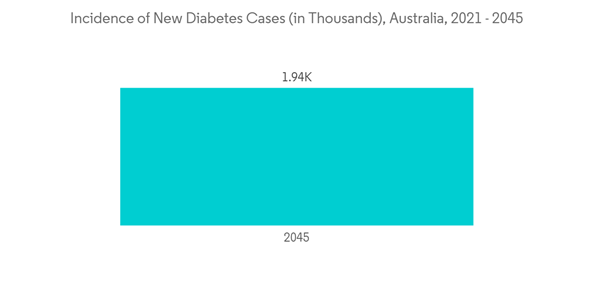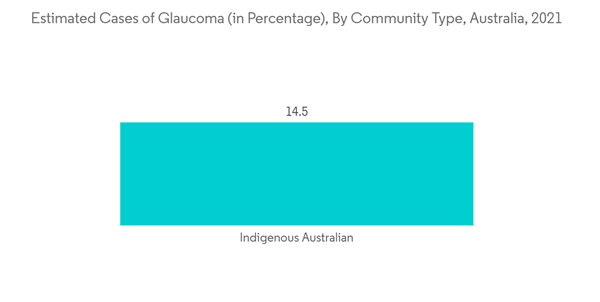The market for ophthalmic devices suffered during the lockdown, primarily as a result of fewer clinical or hospital visits. The ocular surface has been proposed as a potential site of exposure and infection by SARS-CoV-2, with COVID-19 patients developing ocular surface symptoms and follicular conjunctivitis, according to a research study published in the National Library of Medicine in January 2022, stated that ophthalmological community responded in part by increasing the use of telemedicine services, changing the triaging for surgical procedures and strengthening the use of personal protection equipment (PPE) (including the use of slit lamp breath shields). Thus, the COVID-19 pandemic severely curtailed ophthalmology services initially, currently as the pandemic has subsided the market has gained some traction, and thus the market is expected to have stable growth during the forecast period of the study.
Factors such as increasing vision impairment and initiatives by key market players are expected to increase the market growth. According to the WHO October 2021 update, rates of untreated near vision impairment are estimated to be greater than 80% in western, eastern, and central sub-Saharan Africa, compared to comparative rates in high-income regions of North America, Australia, and Western Europe, and Japan. The introduction of new goods and regulatory agency approvals have also significantly contributed to the market expansion. For instance, in June 2021, the Therapeutic Goods Administration (TGA) of Australia granted regulatory approval to Glaukos Corporation for the PRESERFLO MicroShunt, which is intended to lower intraocular pressure (IOP) in the eyes of individuals with primary open-angle glaucoma. These approvals are fueling the country's market expansion.
Although there have been advancements, the devices are stilled deemed unsafe, and can cause damages if not handled professionally, which might restrain the market growth.
Australia Ophthalmic Devices Market Trends
Vision Correction Devices are Expected to Register a High Growth CAGR Over the Forecast Period
Vision correction devices or corrective lenses are used to aid and improve vision for those with common refractive errors like myopia, hypermetropia, astigmatism, and presbyopia. These visual impairments result in low vision. Moreover, these conditions seem to be rising in Australia, which helps increase the ophthalmic devices market.Another aspect of the market's expansion is the rising prevalence of diabetes in the nation. According to the International Diabetes Federation, there were approximately 1,491.8 (in thousands) adult cases of diabetes in Australia in 2021, and that number is predicted to rise to 1,935.2 (in thousands) in 2045. In the upcoming years, the need for vision correction equipment for diagnostic procedures would be anticipated to increase due to the growing patient population. For instance, in November 2022, the Australia and New Zealand Child Myopia Working Group released a new report which stated that the COVID-19 pandemic appears to have had a dramatic impact on the progression of myopia. Myopia prevalence rose significantly in young schoolchildren during the COVID-19 pandemic with prevalence increasing by almost 400% in six-year-olds. This substantial myopic shift has not been seen in any other year to year comparison, making the cause possible due to the unusual occurrence of home confinement in 2020. As myopia becomes more comm, there will be a greater demand for vision correction technology.
Product launches are another factor in market growth. For instance, in September 2020, the Queensland University of Technology based in Australia stated that it is developing a new therapeutic contact lens that acts as a bandage for ocular surface injuries. Similarly, in August 2020, Bausch + Lomb received approval from Australia's Therapeutic Goods Administration (TGA) for the supply of BAUSCH + LOMB ULTRA ONE DAY daily disposable silicone hydrogel (SiHydaily) contact lenses.
Thus, due to the abovementioned factors, the market is expected to grow in the future.
Intraocular Lenses Segment is Expected to Have Significant Share Over the Forecast Period
An intraocular lens (IOL) is a lens that is implanted in the eye, usually replacing the existing crystalline lens. The increasing prevalence of cataracts is one of the key factors in segmental growth. For instance, in October 2022, a research article published by the Sax Institute stated that cataract is a leading cause of visual impairment in Australia, affecting 20% of Aboriginal and Torres Strait Islander (Indigenous) people (40 years and older) and 14% of non-Indigenous Australians (50 years and older).1 People with cataracts experience blurred vision, reduced contrast sensitivity, and increased glare sensitivity, affecting their ability to work, care for others, drive, and perform activities of daily living. Vision loss from cataracts disproportionately affects Indigenous Australians (adjusted odds ratio: 2.95) and people with lower educational attainment and socioeconomic status. In addition, the Royal Australian and New Zealand College of Ophthalmologists in January 2022 stated that glaucoma is characterized by an increase in intraocular pressure that necessitates long-term treatment. Glaucoma is estimated to affect 2.2% of Australians over the age of 50. By 2025, Australia's glaucoma prevalence is expected to rise to 379,000 patients. Thus, the increasing prevalence of cataracts and glaucoma is expected to increase the adoption of intraocular lenses which is expected to increase segmental growth.The expansion of new market players in the country is another factor in market growth. For instance, in September 2020, Alcon launched AcrySof IQ Vivity IOL in Australia. Vivity is a non-diffractive extended depth of focus IOL with Alcon’s proprietary non-diffractive X-WAVE technology, which stretches and shifts light without splitting it. Thus, the increasing prevalence of vision impairment coupled with expansions by key market players is expected to increase segmental growth over the forecast period.
Australia Ophthalmic Devices Market Competitor Analysis
Australia has a well-structured and developed healthcare system. Australia also promotes research and development for pharmaceutical devices and hence has a very high expenditure on healthcare. As a result of these policies, many companies globally are encouraged to operate in the region, which makes the market competitive. Australia ophthalmic devices market is moderately competitive and consists of several major players. Some of the companies that are currently dominating the market are Alcon Inc. Bausch Health Companies Inc, Johnson and Johnson, Carl Zeiss Meditec AG, and Ziemer Ophthalmic Systems AG among others.Additional benefits of purchasing the report:
- The market estimate (ME) sheet in Excel format
- 3 months of analyst support
This product will be delivered within 2 business days.
Table of Contents
Companies Mentioned (Partial List)
A selection of companies mentioned in this report includes, but is not limited to:
- Alcon Inc.
- Bausch Health Companies Inc.
- Carl Zeiss Meditec AG
- EssilorLuxottica SA
- HAAG-Streit Group
- Hoya Corporation
- Johnson and Johnson
- Nidek Co. Ltd
- Topcon Corporation
- Ziemer Ophthalmic Systems AG
Methodology

LOADING...










